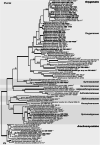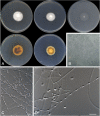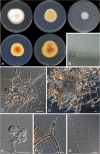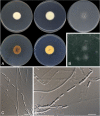A revision of malbranchea-like fungi from clinical specimens in the United States of America reveals unexpected novelty
- PMID: 34493345
- PMCID: PMC8422767
- DOI: 10.1186/s43008-021-00075-x
A revision of malbranchea-like fungi from clinical specimens in the United States of America reveals unexpected novelty
Abstract
The fungi of the order Onygenales can cause important human infections; however, their taxonomy and worldwide occurrence is still little known. We have studied and identified a representative number of clinical fungi belonging to that order from a reference laboratory in the USA. A total of 22 strains isolated from respiratory tract (40%) and human skin and nails (27.2%) showed a malbranchea-like morphology. Six genera were phenotypically and molecularly identified, i.e. Auxarthron/Malbranchea (68.2%), Arachnomyces (9.1%), Spiromastigoides (9.1%), and Currahmyces (4.5%), and two newly proposed genera (4.5% each). Based on the results of the phylogenetic study, we synonymized Auxarthron with Malbranchea, and erected two new genera: Pseudoarthropsis and Pseudomalbranchea. New species proposed are: Arachnomyces bostrychodes, A. graciliformis, Currahmyces sparsispora, Malbranchea gymnoascoides, M. multiseptata, M. stricta, Pseudoarthropsis crassispora, Pseudomalbranchea gemmata, and Spiromastigoides geomycoides, along with a new combination for Malbranchea gypsea. The echinocandins showed the highest in vitro antifungal activity against the studied isolates, followed by terbinafine and posaconazole; in contrast, amphotericin B, fluconazole, itraconazole and 5-fluorocytosine were less active or lacked in vitro activity against these fungi.
Keywords: Antifungals; Arachnomycetales; Auxarthron; Clinical fungi; Malbranchea; New taxa; Onygenales.
© 2021. The Author(s).
Conflict of interest statement
The authors declare that they have no competing interests.
Figures











Similar articles
-
Evidence for a phylogenetic connection between Coccidioides immitis and Uncinocarpus reesii (Onygenaceae).Microbiology (Reading). 1994 Jun;140 ( Pt 6):1481-94. doi: 10.1099/00221287-140-6-1481. Microbiology (Reading). 1994. PMID: 7915941
-
New Species Spiromastigoides albida from a Lung Biopsy.Mycopathologia. 2017 Dec;182(11-12):967-978. doi: 10.1007/s11046-017-0179-8. Epub 2017 Sep 11. Mycopathologia. 2017. PMID: 28894998
-
In vitro susceptibilities of zygomycetes to conventional and new antifungals.J Antimicrob Chemother. 2003 Jan;51(1):45-52. doi: 10.1093/jac/dkg020. J Antimicrob Chemother. 2003. PMID: 12493786
-
In vitro antifungal activities of anidulafungin and micafungin, licensed agents and the investigational triazole posaconazole as determined by NCCLS methods for 12,052 fungal isolates: review of the literature.Rev Iberoam Micol. 2003 Dec;20(4):121-36. Rev Iberoam Micol. 2003. PMID: 15456349 Review.
-
In vitro activities of antifungal drugs against environmental Exophiala isolates and review of the literature.Mycoses. 2018 Aug;61(8):561-569. doi: 10.1111/myc.12779. Epub 2018 Jun 13. Mycoses. 2018. PMID: 29611230 Review.
Cited by
-
200 years of taxonomic confusion: Sporendonema and allies.Antonie Van Leeuwenhoek. 2024 Mar 14;117(1):53. doi: 10.1007/s10482-024-01935-3. Antonie Van Leeuwenhoek. 2024. PMID: 38483617 Free PMC article.
-
Fungal Planet description sheets: 1697-1780.Fungal Syst Evol. 2024 Dec;14:325-577. doi: 10.3114/fuse.2024.14.19. Epub 2024 Dec 6. Fungal Syst Evol. 2024. PMID: 39830292 Free PMC article.
-
Insights into Some Onygenalean Fungi from Freshwater Sediments in Spain and Description of Novel Taxa.J Fungi (Basel). 2023 Nov 22;9(12):1129. doi: 10.3390/jof9121129. J Fungi (Basel). 2023. PMID: 38132730 Free PMC article.
-
Unravelling the fungal darkness in a tropical cave: richness and the description of one new genus and six new species.Fungal Syst Evol. 2022 Dec;10:139-167. doi: 10.3114/fuse.2022.10.06. Epub 2022 Nov 1. Fungal Syst Evol. 2022. PMID: 36741552 Free PMC article.
-
Name Changes for Fungi of Medical Importance, 2020 to 2021.J Clin Microbiol. 2023 Jun 20;61(6):e0033022. doi: 10.1128/jcm.00330-22. Epub 2023 Mar 28. J Clin Microbiol. 2023. PMID: 36975779 Free PMC article. Review.
References
-
- Cain RF. Studies of coprophilous ascomycetes. IV. Species from the Hudson bay area. Canadian Journal of Botany. 1957;35:255–268. doi: 10.1139/b57-022. - DOI
-
- Carmichael JW, Kraus HJ. The cattle ringworm fungus, Trichophyton verrucosum, in Alberta. Alberta Medical Bulletin. 1959;24:201–203.
Grants and funding
LinkOut - more resources
Full Text Sources
